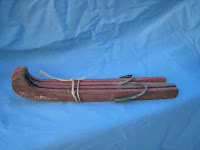-------------------------------------------------
Stand in your bare feet in front of a mirror, posed so you can see the lower half of your legs and ankles as well as your feet. Do your ankles bend inwards, like in the image below? It can be on one side, or on both. If your ankle bends inward, that's pronation. Don't panic. It's so common that most people have some form of it, and it doesn't bother them.
So what causes pronation? Lots of things. But I've read of two. First one, the first metatarsal bone is too short. (I've got that one). In the second, there's something in the construction of the ankle or heel bone that effectively makes the heel roll inwards. You cannot believe how complicated the bones of the ankle and heel are. Let's just call this a 'stubby heel'. Really, I don't suppose it matters. We're kind of limited as to our fixes in our boots, I just wanted to show that it wasn't just one issue that causes it.
Because we're skaters, pronation can be a real problem. It can drive us onto our inside edges and make it difficult to get to our outside edges. Remember, my posting on the line of gravity? Well, it comes in here too, The line of gravity wants to go straight down from your hip to the center of the earth. If you don't pronate, then that line will go straight through your ankle and heel and you'll be beautifully balanced. If you do pronate, that line of gravity will bypass your ankle and you'll never get good balance, unless you can get your ankle set so that line of gravity passes through it.
Here in this picture on the left, you see the figure with a pronated right foot. See how the line of gravity bypasses the foot and ankle? Hard to balance on that, right? Well, if the foot's not too badly pronated, you can curl up your big toes and rotate the foot outward. That will put your ankle and heel in line with the line of gravity.
See in the left leg of the figure, how the line of gravity passes straight through the ankle. Much easier to balance.
If you have pronation, stand on one foot. What are you doing? What I do it put my weight on the heel and curl my first two toes to rotate my feet outward. If I was able to put a wedge under the inside edge of my foot, then I would be much more stable, and would't have to strain my toes.
If you want to see a close up picture of the line of gravity passing down the leg here's one below.
 | ||||||||||||||||||
| The pink outline shows a neutral foot The black line shows a pronated foot |
Tomorrow I'll start with strengthening the foot.

























